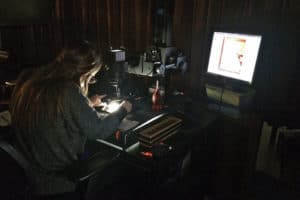Digital preservation is the only way to maintain existing and future digital resources in which your organization has invested time, money, and personnel resources. Many cultural heritage materials will never exist as anything other than digital objects. Without a program to preserve them, these materials will be lost to time.
The best type of program is an interlocking system of policies, workflows, technical solutions, and efforts meant to keep digital objects usable in the long term. Digital objects are made up of bitstreams—sequences of 1s and 0s that require specific software and hardware environments to remain accessible. Some are born digital (those materials with no original analog counterpart); others are digitized copies of physical materials.
Over time, digital materials have evolved from single files into complex systems in which many smaller parts work together to form a whole—for example, an accessible film is made up of an audio track, moving image, and caption files.
The goal of a digital preservation program is to provide access to authentic copies of digital objects. This does not always mean that a future user will experience the digital object as it was when it was created, though this is ideal. Instead, an authentic digital object can be defined as one that has had no unauthorized changes made to it and maintains verifiable, transparent documentation of what changes (if any) were made to preserve the content and when those changes occurred. Your organization can say that it has preserved an authentic digital object when the content, context, appearance, structure, and behavior of the digital object have been saved for future users to experience.
No silver bullet guarantees the creation of a digital preservation program. It is an ever-evolving effort to keep up with your organization’s current needs while planning for future circumstances.
Digital objects need constant monitoring and intervention to remain usable. Therefore, digital preservation is an iterative cycle of assessment, policy development and refinement, implementation, and maintenance. Digital preservation can seem intimidating to anyone new to the practice, inducing decision paralysis about where to start.
Digital preservation can seem intimidating to anyone new to the practice, inducing decision paralysis.
Failure to decide is what causes the most damage to digital objects. Doing nothing will guarantee that your fragile digital materials will decay. The damage might never be ameliorated by future efforts. The critical part of digital preservation is doing something. What that something is will depend upon the specific needs and abilities of your organization.
At its core, digital preservation is an exercise in risk management. You will build your entire program around what you and your organization determine to be an acceptable risk of loss of the usable and authentic digital materials in your care.
Assess the digital materials in your possession, then determine what may come your way in the future. Balance this with your available technological, staff, and financial resources to map out a plan for your efforts. Use that plan to create policies, implement workflows, and build up institutional knowledge of digital preservation.
Work within your organization to build strong relationships with other departments, such as information technology support, that will provide crucial backing for your digital preservation efforts. Collaborate with external partners to build capacity together.
Constantly review the wider, international landscape of digital preservation to help increase your own knowledge and abilities, then transfer these skills right back into your program. Pick a starting point and go full steam ahead—because if you don’t, your unique digital resources will disappear.


